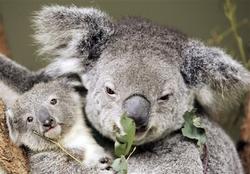 Koalas are threatened by the rising level of carbon dioxide pollution in the atmosphere because it saps nutrients from the eucalyptus leaves they feed on, a researcher said Wednesday. Koalas are threatened by the rising level of carbon dioxide pollution in the atmosphere because it saps nutrients from the eucalyptus leaves they feed on, a researcher said Wednesday.
Ian Hume, emeritus professor of biology at Sydney University, said he and his researchers also found that the amount of toxicity in the leaves of eucalyptus saplings rose when the level of carbon dioxide within a greenhouse was increased.
Hume presented his research on the effects of carbon dioxide on eucalyptus leaves to the Australian Academy of Science in Canberra on Wednesday.
The researchers found that carbon dioxide in eucalyptus leaves affects the balance of nutrients and "anti-nutrients" - substances that are either toxic or interfere with the digestion of nutrients.
An increase in carbon dioxide favors the trees` production of carbon-based anti-nutrients over nutrients, so leaves can become toxic to koalas, Hume said.
Some eucalyptus species may have high protein content, but anti-nutrients such as tannins bind the protein so it cannot be digested by koalas.
Hume estimated that current levels of global carbon dioxide emissions would result in a noticeable reduction in Australia`s koala population in 50 years due to a lack of palatable leaves.
Out of more than 600 eucalyptus species in Australia, koalas will only eat the leaves of about 25, Hume said. Changing the toxicity levels in the trees could further reduce the varieties that koalas find palatable, he said.
"Koalas produce one young each year under optimal conditions, but if you drop the nutritional value of the leaves, it might become one young every three or four years," Hume said.
Hugh Tyndale-Biscoe, a marsupial physiologist, described Hume`s predictions of declining koala numbers as speculative but credible.
Eucalyptus leaves already have little nutritional value, he said, and koalas have adapted to their poor diet by sleeping to conserve energy.
"It`s a very precarious existence," Tyndale-Biscoe said. "They basically sleep for 20 hours a day and then they`ve got four hours to do everything else - occasionally eat a leaf and maybe once a year go after another koala" to mate.
Tyndale-Biscoe said koalas had already disappeared from parts of Australia but remained plentiful in others and were unlikely to be wiped out by climate change. They already have been displaced from the most nutritious trees on the most fertile land by the spread of farms and suburbs, he said.
sections: Nature & Health, World News
|